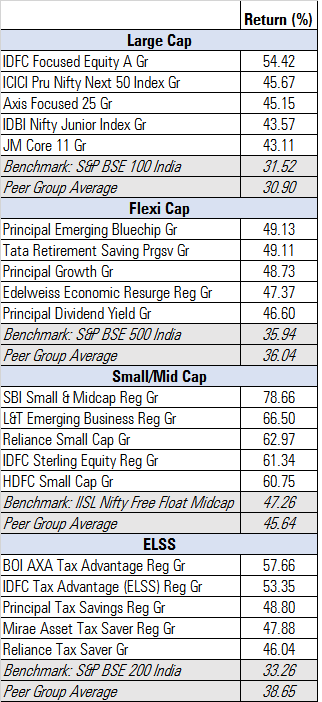Here’s a look at the best funds of 2017. Do note, this is just a listing and NOT a recommendation. Morningstar Analysts looked at the Growth schemes (not dividend) of Regular plans (not direct). The 1-year returns are as on December 31, 2017. The source of the data is Morningstar Direct. While IDFC Focused Equity A is currently categorized as a large-cap fund, it is a candidate for a category change given the change in its investment pattern. Last year, IDFC Imperial Equity got renamed and adopted a more flexible mandate from its earlier large-cap one.

Came across this listing on the Morningstar India website.
We are witnessing a historic shift in the savings pattern of Indian households. Recent RBI reports have shown a steady improvement in household financial savings as a percentage of Gross National Disposable Income (GNDI). As per the initial estimates, the net financial savings for FY17 was around 8.1% of the GNDI as compared to 7.8% in FY16. With the shift in savings patterns of Indian households, investors are looking for opportunities beyond the traditional avenues. This shift, along with the excess liquidity post demonetisation and positive investor sentiments, has played a key role in the growth of the mutual fund industry.
We saw phenomenal growth of mutual funds, reflected through a striking 38.4% growth in assets in the past 11 months ending November 2017 to reach Rs 22.79 lakh crore. In terms of folio count, the aggregate count at the end of November 2017, stood at 6.49 crore, up considerably from 5.20 crore a year ago period. Further, the industry has seen the highest-ever net inflows of Rs.4.08 lakh crore during the year along with an increase in retail investors’ participation which stands at 99.4% of the total investor base today. Individual investors favoured investments in equity mutual funds leading to a surge in their share by 65% in the past one year. Massive investor education programmes like ‘Mutual Fund Sahi Hai’ to increase penetration of mutual funds are paying dividends as is reflected in the increased participation from retail investors.
Financialisation of savings through mutual funds is supported by the fact that they not only provide products to investors but also provide solutions for investor needs through different facilities like SIPs, SWPs and STPs. While considering different financial assets for investments, investors look for better returns and liquidity, tax efficiency and fulfilment of goals. Mutual funds support all these as they have the potential to deliver better returns, have the inherent liquidity feature and are comparatively tax efficient as compared to traditional investments. Investors can take this benefit further by utilising facilities like SIPs and SWPs and work towards creating wealth and regular income in a tax-efficient manner. We have been able to build a disciplined approach towards investments.
This is reflected in the growth of mutual fund SIP books, both in terms of size and numbers. During the current financial year, the industry added close to 9.05 lakh SIP accounts each month on an average and the total number of SIP accounts now stand at a whopping 1.80 crore. This reflects the fact that there is a gradual behavioural change among Indian investors and they are considering mutual funds through SIPs for the long-term wealth creation goal. With the demonetisation effect, shift to financial savings, rapid digitalisation and improving investor education, the next two–three years should see mutual fund assets reaching another great milestone. The robust asset growth is expected to continue going forward, driven by developments across product offerings, ongoing technological advancements and regulatory reforms. The mutual fund industry is at an inflection point and set to become a part of investment consideration of every investor, thereby making mutual funds a preferred choice for savings and investments.


